When using small appliances on one circuit, it’s crucial to stay within your circuit’s wattage limits, usually between 1,800 and 2,400 watts for typical home circuits. Add up the wattages of your devices, like blenders, coffee makers, and toasters, to avoid overloads, breaker trips, or electrical hazards. If you notice frequent trips or flickering, your circuit may be overloaded. Stay cautious—if you keep exploring, you’ll discover more tips for safe and efficient appliance use.
Key Takeaways
- Most home circuits support 15-20 amps, translating to about 1,800-2,400 watts maximum load.
- Add up all appliance wattages on the same circuit to ensure total stays within breaker limits.
- Typical small appliances use 300–1500 watts; avoid exceeding circuit capacity when multiple devices are connected.
- Use energy-efficient appliances to reduce load and prevent circuit overloads.
- Signs of overload include tripped breakers, flickering lights, warm outlets, or burning smells.
Understanding Circuit Capacity and Wattage Limits
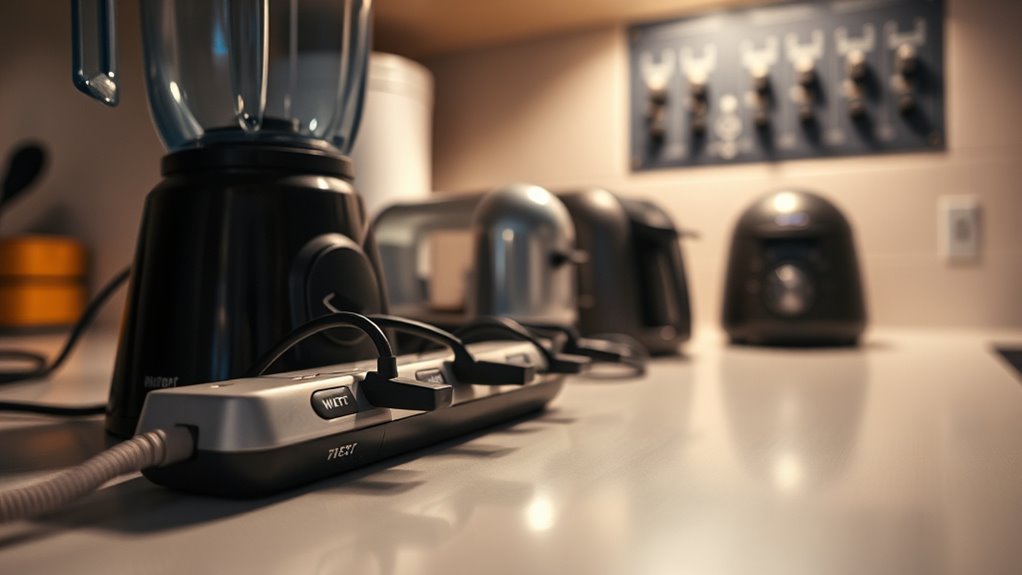
Understanding circuit capacity and wattage limits is essential to safely using small appliances on a single circuit. Your circuit breaker ratings indicate the maximum current your wiring can handle without tripping or risking damage. Most home circuits are rated for 15 or 20 amps, meaning they can safely support a specific wattage—typically around 1,800 to 2,400 watts. Staying within these limits ensures wattage safety and prevents overloads. Overloading a circuit can cause the breaker to trip or, worse, electrical hazards like shorts or fires. Always check the ratings on your circuit breaker panel before plugging in multiple appliances. Knowing your circuit’s capacity helps you avoid overloading and keeps your electrical system running smoothly and safely. Home electrical safety is crucial for preventing accidents and maintaining appliance longevity.
Common Small Appliances and Their Typical Power Usage
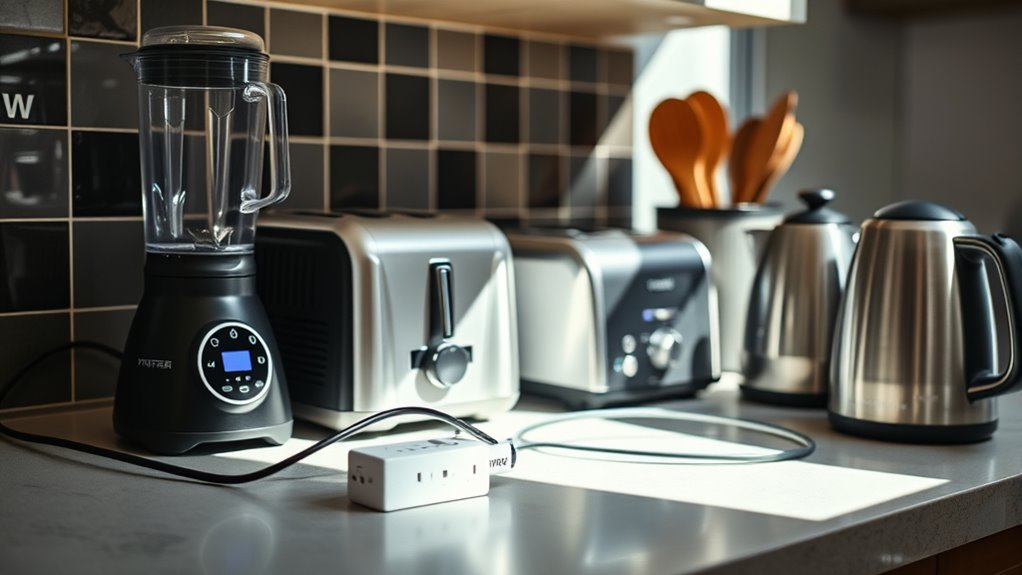
Many small appliances fall within specific power ranges, making it easier to plan your circuit loads. You’ll find that devices like toasters, blenders, and coffee makers typically use between 300 and 1500 watts. Luckily, energy-efficient options are available that can help you reduce overall power consumption without sacrificing performance. For instance, choosing appliances with Honda Tuning technologies can enhance efficiency and prolong device lifespan.
Typical Appliance Power Ranges
Small appliances typically have power ratings that fall within a predictable range, making it easier to plan for safe circuit use. Most small kitchen gadgets, like blenders and toasters, use between 300 and 1,200 watts. Compact microwaves usually consume around 600 to 1,000 watts, while coffee makers often range from 600 to 1,000 watts as well. Knowing these ranges helps you avoid overloading circuits and extends your appliance lifespan through proper maintenance tips, such as cleaning vents and avoiding overheating. Smaller appliances generally use less power but can still cause circuit issues if multiple high-wattage devices run simultaneously. By understanding typical power ranges, you can better manage your kitchen’s electrical load, ensuring safety and longevity for your appliances. Additionally, understanding the Volkswagen Tuning concepts can help you optimize your vehicle’s performance without risking electrical overloads.
Energy-Efficient Options Available
Are you looking to cut energy costs without sacrificing performance? Modern small appliances offer energy-efficient options that help you save power while still meeting your needs. Look for models with the Energy Star label or low wattage ratings, which are designed to optimize appliance compatibility with your circuit. Here’s a quick comparison:
| Appliance Type | Typical Power Usage |
|---|---|
| Blender | 300–700W |
| Coffee Maker | 800–1500W |
| Toaster | 800–1500W |
Using energy saving tips, like choosing appliances that suit your usage patterns, guarantees you stay within your circuit’s limits. These options let you enjoy your favorite devices without overloading your circuit or wasting energy. Additionally, understanding the 16PF traits associated with appliance usage can help you select devices that align with your personality and lifestyle preferences.
How to Calculate Total Wattage on a Single Circuit
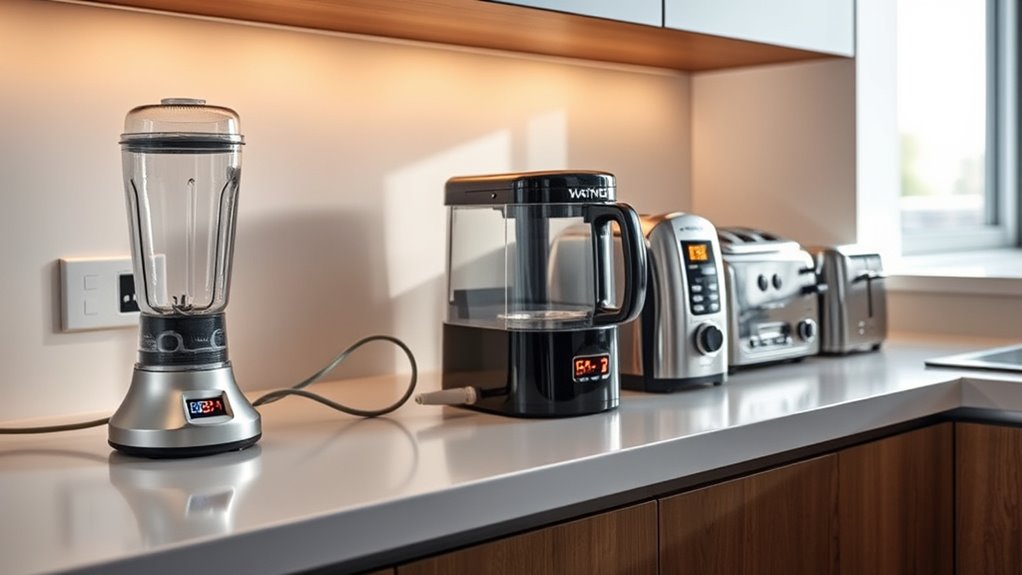
To determine the total wattage on a single circuit, you need to add up the wattages of all the appliances and devices plugged into it. Start by checking each device’s wattage, usually listed on the label or in the manual. Sum these numbers to get the total load. Remember, your circuit breaker is designed to prevent overloads, so don’t exceed its capacity, typically 15 or 20 amps. Overloading can cause power surges, risking damage to appliances or tripping the breaker. Keep in mind that wattage calculations should include every device on the circuit, even small appliances. Additionally, understanding the importance of proper placement and maintenance helps ensure effective operation of devices like air purifiers. By accurately totaling wattage, you guarantee your circuit remains safe and functional, avoiding unnecessary interruptions or hazards.
Signs That Your Circuit Is Overloaded
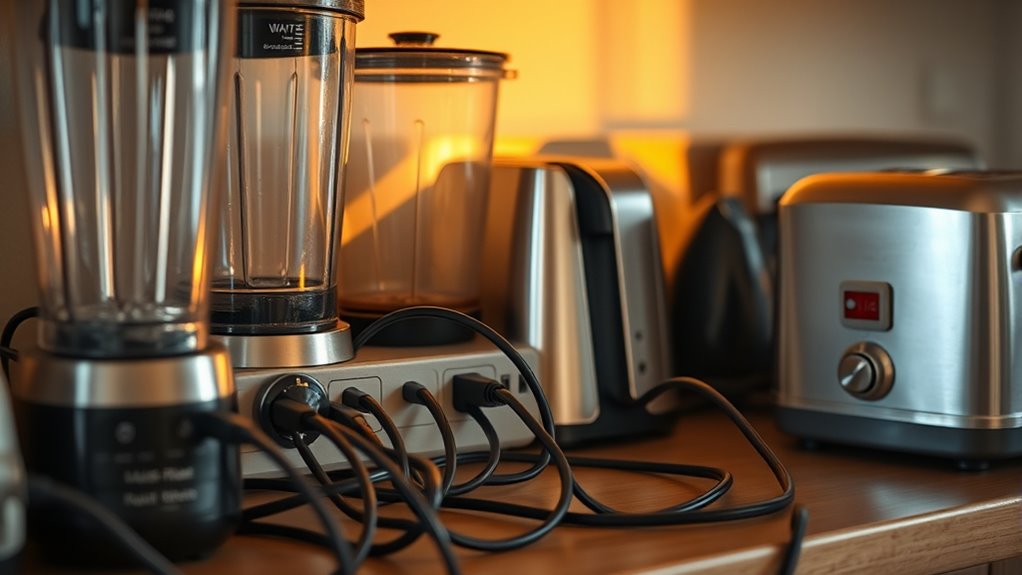
When your circuit becomes overloaded, you might notice several warning signs that indicate it’s time to take action. Frequently tripped circuit breakers are a clear sign, especially if they happen repeatedly during normal use. Flickering lights or dimming when appliances turn on also suggest overload. You may feel a warmth or smell burning around outlets or switches, which indicates excessive heat buildup. If your electrical system isn’t up to code, it could be more prone to overloads, so regular circuit breaker testing is essential for safety. Ignoring these signs risks damaging appliances or causing electrical fires. Ensuring electrical code compliance helps prevent overloads and maintains a safe, reliable electrical system in your home. Staying aware of these signs and proper maintenance practices can help prevent dangerous overload situations.
Tips for Safe and Efficient Appliance Usage
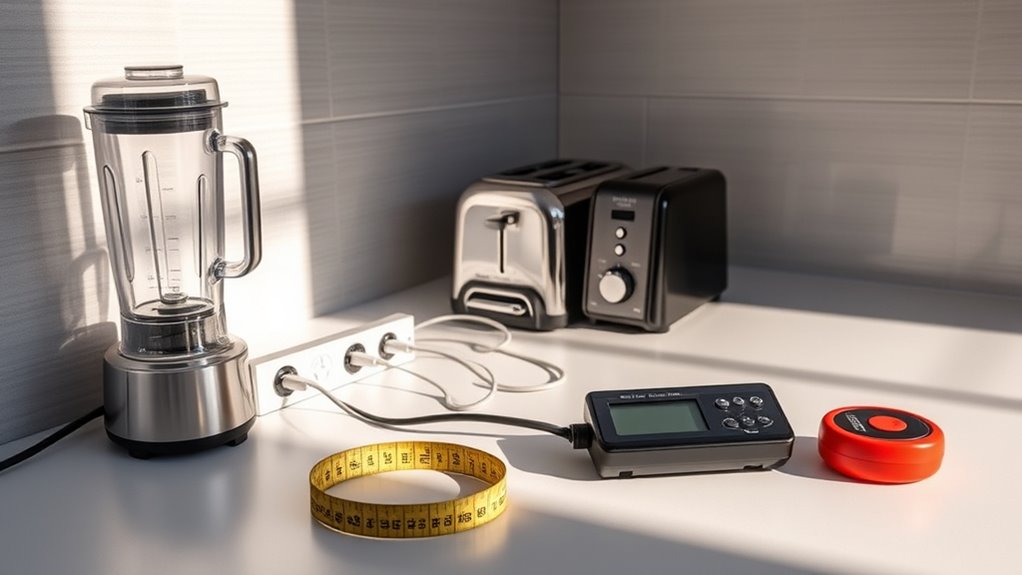
Using small appliances safely and efficiently starts with understanding their wattage and how much power your circuits can handle. Always check the appliance’s wattage and avoid overloading circuits, which can trip your circuit breaker or cause electrical hazards. Grounding safety is essential; ensure appliances are properly grounded to prevent shocks. Familiarize yourself with the different circuit breaker types in your home—standard, GFCI, or AFCI—and use the appropriate breaker for appliance protection. Avoid daisy-chaining multiple devices on one outlet, and unplug appliances when not in use to prevent overheating. Regularly inspect cords for damage, and never bypass safety features. Being aware of your home electrical system helps maximize efficiency, minimizes risks, and keeps your home safe while using small appliances. Following these tips helps maximize efficiency, minimizes risks, and keeps your home safe while using small appliances.
When to Consider Upgrading Your Electrical System
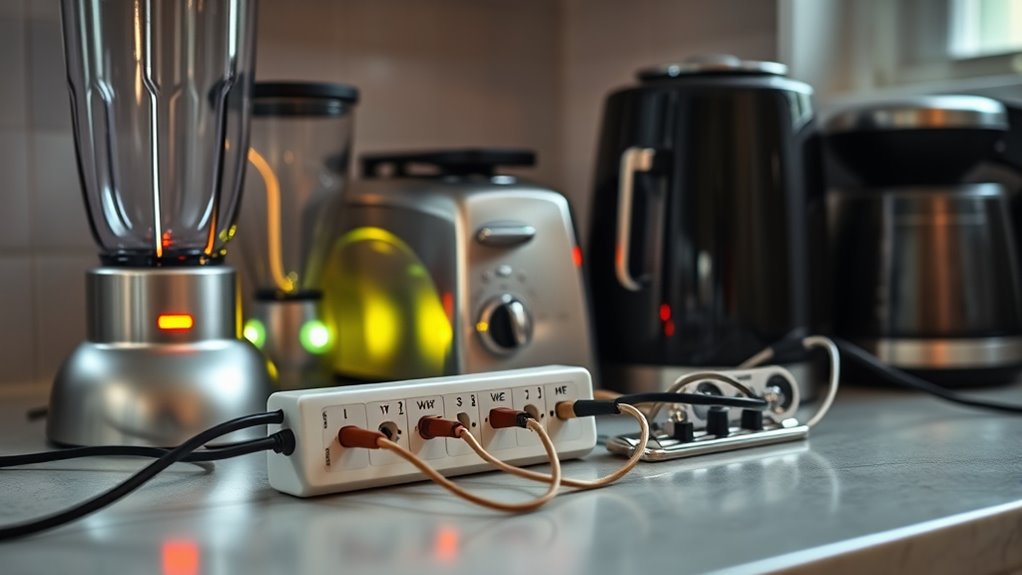
Recognizing the signs that your electrical system needs an upgrade can prevent potential hazards and improve overall safety. If your circuit breaker trips frequently or feels warm to the touch, it’s a clear indicator that you may need circuit breaker upgrades. Additionally, consider wiring capacity considerations—if your wiring is outdated or undersized for your current power demands, it can pose fire risks. When adding new appliances or renovating your home, it’s wise to evaluate whether your existing system can handle the increased load. An upgrade ensures your wiring and breaker can safely support your needs, reducing the risk of electrical failures or fires. Regularly assessing the system’s capacity is crucial for maintaining electrical safety. Consulting a licensed electrician can help determine if your system requires an upgrade and guide you through the necessary improvements.
Frequently Asked Questions
Can Multiple High-Wattage Appliances Run Simultaneously Without Tripping the Breaker?
You can run multiple high-wattage appliances simultaneously if they’re compatible with your circuit capacity. Check each appliance’s wattage and make certain the total doesn’t exceed the circuit’s limit, typically 15 or 20 amps. Appliance compatibility and understanding your circuit capacity prevent overloads and tripping breakers. Spread out high-wattage devices across different circuits when possible, and avoid running several heavy appliances at once on the same circuit.
What Are the Best Practices for Balancing Appliance Loads Across Circuits?
You should aim to keep appliance loads under 80% of your circuit’s capacity for safety. For effective circuit planning, distribute high-wattage devices evenly across different circuits. For example, if a circuit supports 15 amps, don’t overload it with multiple heavy appliances. Load balancing prevents tripped breakers and prolongs your wiring’s life. Regularly assess your appliance use, and adjust loads accordingly to guarantee safe, efficient operation in your home.
How Do Surge Protectors Affect Small Appliance Wattage Limits?
Surge protectors can impact small appliance wattage limits because their ratings determine how much power they can handle safely. You should check surge protector ratings to make sure they match your appliances’ wattage needs. Also, consider appliance compatibility; some devices may not work well with certain surge protectors. Using a surge protector with appropriate ratings helps prevent overloads and protects your appliances without exceeding safe wattage limits.
Are There Specific Circuit Types Recommended for Large Kitchen Appliances?
You should use dedicated circuits for large kitchen appliances like ovens or refrigerators. Look for circuits with high amperage ratings, such as 20 or 30 amps, to guarantee compatibility with your appliances’ wattage needs. Always check the circuit’s compatibility with your appliance’s electrical requirements, and avoid sharing circuits to prevent overloads or tripped breakers. Proper circuit compatibility guarantees safe, efficient operation for your big kitchen appliances.
How Does Wire Gauge Influence Maximum Appliance Wattage on a Circuit?
Your wire gauge, or wire size, directly impacts how much wattage your circuit can safely handle. Thicker wires (lower gauge numbers) can carry more current without overheating, allowing higher wattage appliances to run simultaneously. Conversely, thinner wires (higher gauge numbers) limit the maximum appliance wattage. Always match your wire gauge to your appliances’ power needs to prevent overloads and guarantee safety on your circuit.
Conclusion
Remember, a chain is only as strong as its weakest link. Keep your circuits balanced and avoid overloads to protect your home and appliances. Regularly check your wattage limits and listen to your electrical system’s signals. When in doubt, don’t push your luck—safety first. Staying informed and cautious guarantees your home runs smoothly, and you avoid costly surprises. After all, an ounce of prevention is worth a pound of cure.










